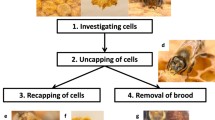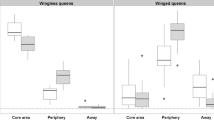Abstract.
Honeybee workers, Apis mellifera, usually do not reproduce but can activate their ovaries under queenless conditions to produce male offspring. As an exception to this rule, laying workers of the Cape honeybee, A. m. capensis, parthenogenetically produce diploid female offspring, usually developing into workers and occasionally into queens. Some of such workers can develop into pseudoqueens, which show high ovarial development and a queenlike pheromonal bouquet. Because there is high genetic variance for these characters, this results in an extreme intracolonial selection. This process is governed by a competition for reproductive dominance among workers, leading into a facultative social parasitic reproductive pathway as part of the life history of the Cape honeybee. A. m. capensis workers show an increased potential for invading foreign colonies. Inside of the host colony, parasitic A. m. capensis workers produce queenlike pheromones and swiftly activate the ovaries, despite the presence of a queen. Eventually they establish themselves as pseudoqueens and replace the host queen. The parasitic worker offspring is preferentially fed by the host workers, leading to highly virulent intercastes and thereby completing the social parasitic life cycle of laying A. m. capensis workers. Recently, a particularly virulent parasitic strain of A. m. capensis workers has invaded the neighboring subspecies A. m. scutellata (”capensis calamity”). Because male sexuals are completely lacking in this invasive strain and female reproductives are never reared in infested A. m. scutellata host colonies, this results in reproductive isolation of the parasitic clones from the host gene pool and sets the stage for the evolution of a queenless social parasitic honeybee. The Cape honeybee may therefore constitute a unique subject for studying sympatric speciation of a social parasite.
Similar content being viewed by others
Author information
Authors and Affiliations
Additional information
Electronic Publication
Rights and permissions
About this article
Cite this article
Neumann, .P., Moritz, .R. The Cape honeybee phenomenon: the sympatric evolution of a social parasite in real time?. Behav Ecol Sociobiol 52, 271–281 (2002). https://doi.org/10.1007/s00265-002-0518-7
Received:
Revised:
Accepted:
Issue Date:
DOI: https://doi.org/10.1007/s00265-002-0518-7




